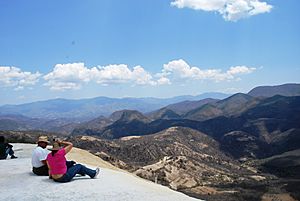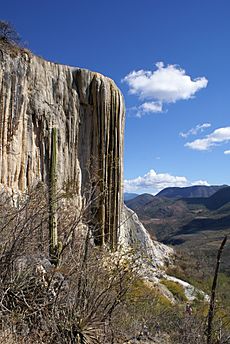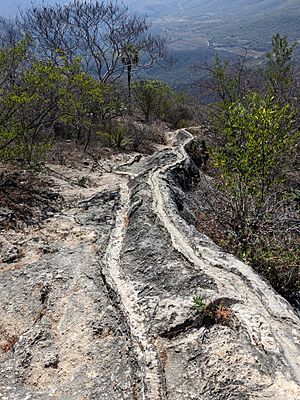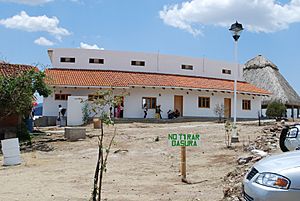Hierve el Agua facts for kids
Quick facts for kids Hierve el Agua |
|
|---|---|
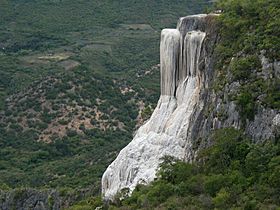
The large "waterfall" at Hierve el Agua
|
|
| Location | San Lorenzo Albarradas, Oaxaca, Mexico |
| Coordinates | 16°51′56″N 96°16′34″W / 16.865519°N 96.276004°W |
Hierve el Agua is a unique natural wonder in Oaxaca, Mexico. Its name means "the water boils" in Spanish. This is because some of its springs bubble up, making it look like the water is boiling. However, the water is not actually boiling hot!
Hierve el Agua is famous for its amazing rock formations. They look just like giant waterfalls that have turned to stone. These "petrified waterfalls" were formed over thousands of years by mineral-rich water flowing over cliffs. The site is about 70 kilometers (43 miles) east of Oaxaca City. It's a popular place for visitors to swim in natural and artificial pools.
Contents
Where is Hierve el Agua?
Hierve el Agua is in a quiet, remote area of Mexico. The land around it is rugged, with lots of oak trees and cactus plants. The "waterfalls" are on cliffs that rise steeply from a narrow valley.
The closest towns are San Lorenzo Albarradas and San Isidro Roaguia. These communities are home to the Mixe people. The springs at Hierve el Agua are one of the few water sources in this dry region.
Amazing Rock Formations
The site has two main waterfall-like rock formations. They have been shaped by nature for thousands of years. Both cliffs are over 50 meters (164 feet) tall from the valley floor. One formation is 12 meters (39 feet) long, and the other is 30 meters (98 feet) long.
The shorter one is called "cascada chica," meaning "small waterfall." It "flows" from a base about 60 meters (197 feet) wide. The longer one is "cascada grande," or "large waterfall." It stretches down from a base about 90 meters (295 feet) wide. This base is 80 meters (262 feet) above the valley.
People often call these formations "salt waterfalls" or "petrified waterfalls." They are created by small amounts of water that are full of calcium carbonate and other minerals. This water comes out of cracks in the mountainside. The water is usually between 22 to 27 °C (72 to 81 °F) (72 to 81°F).
As the water trickles down the rock, it leaves behind minerals. This process is similar to how stalactites form in caves. The amount of water flowing changes between the dry and rainy seasons.
Most of the rock formations are made of calcium carbonate. This mineral gives them a white or nearly white color. Other minerals like silver, barium, and iron can also be present. These minerals can add different colors to the formations. The calcium carbonate comes from rainwater that goes underground. It picks up carbon dioxide, forming a weak acid. This acid then dissolves minerals from underground rocks. When the water comes to the surface, the extra minerals are deposited.
Some people believe the mineral-rich waters have healing properties.
The Amphitheater and Pools
The "cascada chica" is also known as the Amphitheater. It's easier to reach and more often visited. This cliff is over 50 meters (164 feet) high. It has a natural flat area about 60 meters (197 feet) wide. On this platform, there are four springs.
Water from three of these springs fills several small natural pools. It also fills two large artificial pools where visitors can swim. The lower artificial pool is very close to the cliff edge. The water in these pools looks a beautiful turquoise green because of the minerals.
The fourth spring is closest to the cliff edge. It's responsible for most of the "waterfall" rock formation. Two of the springs on the Amphitheater side seem to bubble up from the ground. This bubbling is why the place is called Hierve el Agua, meaning "the water boils." Water constantly flows from these springs, and the mineral depositing process never stops. You can even see new mineral layers forming on the walls of the artificial pools.
Trails lead from the cascada chica to the cascada grande. You can also hike down to the valley floor and explore other nearby areas. The cascada grande is just south of the cascada chica and easy to see from there. This rock formation is more vertical. It's a rock shelf where mineral-rich water flows over the side. This shelf is 90 meters (295 feet) above the valley floor and 80 meters (262 feet) wide. The "waterfall" itself extends down about 30 meters (98 feet). This side does not have artificial swimming pools.
Ancient Canals of Hierve el Agua
Hierve el Agua is also important for its history. The Zapotec people built a huge system of irrigation canals and terraces here. They did this as long as 2,500 years ago! It was likely a special, sacred place for these ancient people.
The canals were part of a large irrigation system. Most of them stretch from the Amphitheater side. Researchers have studied these canals and terraces, which were cut into the mountainsides. They believe this was a unique irrigation system for Mexico.
Only parts of these ancient canals remain today. The area has not been fully explored by archaeologists. These irrigation canals are considered special in Mesoamerica. This is because irrigation was not common in ancient Mexico. Also, these are the only known examples of lined irrigation canals from that time. The lining here formed naturally.
Visiting Hierve el Agua
Besides the swimming pools, there are other services for visitors. You can find food stands, small markets, and even cabins for overnight stays. The cabin area is called "Turis Yu’u." It has a swimming pool and places to change clothes, shower, and eat. The accommodations are simple.
Local people from the Roaguia community own many of these facilities.
Accessing the Site
To enter Hierve el Agua, visitors pay a fee to the state of Oaxaca. Sometimes, local communities also collect a small fee on the road. This is because there have been disagreements between the nearby towns about who should manage the site and share the income. These disagreements have sometimes made it tricky to access the site. For example, the site was closed for a few years between 2005 and 2007.
Local residents have sometimes blocked roads to draw attention to their concerns. This can happen for various reasons, like disagreements over local issues or concerns about tourism. State officials try to prevent these blockades, but sometimes they allow them to avoid bigger conflicts.
See also
 In Spanish: Hierve el Agua para niños
In Spanish: Hierve el Agua para niños
- Badab-e Surt
- Bagni San Filippo
- Baishuitai
- Mammoth Hot Springs
- Pamukkale
- Pink and White Terraces
- Terme di Saturnia
- Huanglong Scenic and Historic Interest Area




